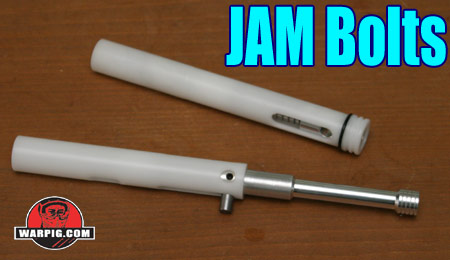  |
|
|
|
|
|
|
  |
|
|
|
|
|
|

What
do you think?
|

JAM Bolts By Bill Mills - June 2005 As paintball technology has developed over the years, one design focus for both paintguns and aftermarket accessories has been to properly feed paintballs without breaking them. Especially with the rough bolt force found in blowback semi-autos, if the bolt closes when a paintball is only partially fed, chances are pretty good that ball will be chopped in half, leaving a gooey mess in the paintgun, and filling the barrel with paint that will cause spin and hook-shots. A few years back the folks at JAM Enterprises came up with a simple solution – the JAM Bolt.
The second piece of the bolt is connected to the first by a spring. In a normal loading situation, both pieces of the bolt move back and forth together, chambering a paintball. In the case of a mis-feed however, the front part of the bolt stops on the obstruction, and the spring compresses while the back portion continues to move forward. The design is a very simple approach to a common problem in that rather than re-designing the paintgun, or adding a ball sensor and electronics, it is built to prevent chops by simply being a gentler bolt.
Since the initial release of the JAM Bolt as an aluminum bolt, JAM Enterprises has moved on to a combination of aluminum and acetal resins (like Delrin – a registered trademark of the DuPont Corp., who’s attorneys send us nasty-grams if we don’t mention them.) This produces a low friction, light weight “self lubricating” bolt, but also gives additional strength where it is needed. While the early JAM bolts were for the Autococker, the company has since produced models for many paintguns including Spyders, Intimidators, and Angels. For review we looked at three JAM Bolts, and put two of them in the field. The Spyder Rear Cocking JAM Bolt has a long rear half, which serves as the cocking knob, and is compatible with a number of rear cocking Spyder Models. It is interesting to note that while the JAM Bolts have been available for a few years now, they have not received as much attention as the very similar anti-jam bolts Kingman is now putting in Spyders, likely due to the power of Kingman’s marketing and advertising compared to that of a smaller company. For the Intimidator and Autococker, the JAM Bolts were a simple drop-in upgrade, though a little extra effort was needed for a proper fit on a CCM J2.
On the field, the bolts worked well, and chopping was not a problem. To try and force a chopping problem, an Apache loader was used on the J2, and simply turned off, so that it would be likely to not keep up under rapid fire. Numerous misfires occurred, but only one resulted in a broken ball with Hellfire paint. Running the bolt without the o-ring to provide minimal friction against the cocking block resulted in no breaks during intentional misfires. With the many options available to combat chopping or paint, the JAM Bolt proved to be a very simple drop in solution. The author would like to thank Clint Marshall for field testing the Intimidator model. |
| Copyright © 1992-2019
Corinthian Media Services. WARPIG's webmasters can be reached through our feedback form. All articles and images are copyrighted and may not be redistributed without the written permission of their original creators and Corinthian Media Services. The WARPIG paintball page is a collection of information and pointers to sources from around the internet and other locations. As such, Corinthian Media Services makes no claims to the trustworthiness or reliability of said information. The information contained in, and referenced by WARPIG, should not be used as a substitute for safety information from trained professionals in the paintball industry. |